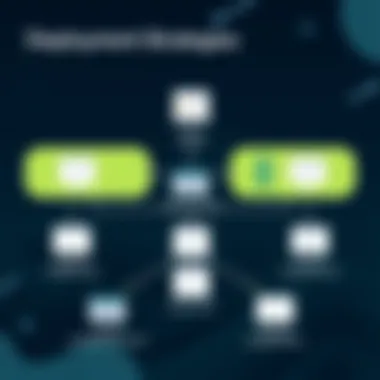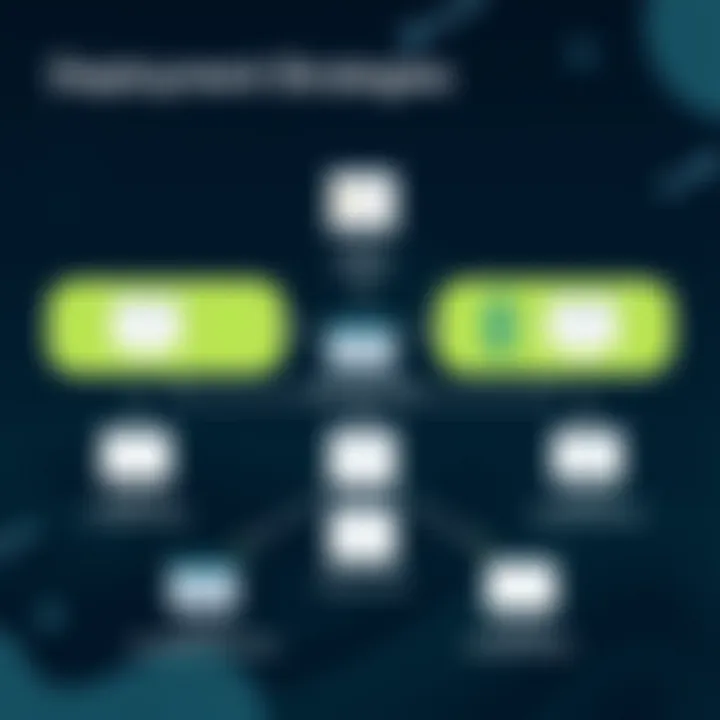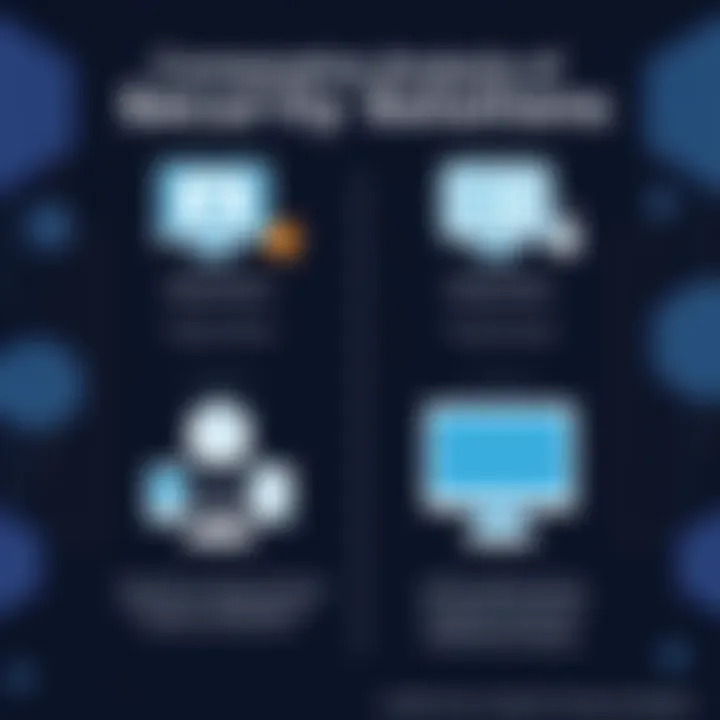Thycotic Server Insights for Business Leaders


Intro
In today’s fast-paced business world, the security of sensitive information has become paramount. Companies face increasing threats from cybercriminals, which underscores the need for robust access controls and security policies. This is where Thycotic Server comes into play, positioning itself as a formidable solution for organizations looking to safeguard their data and streamline user access. Understanding its capabilities, functionalities, and deployment strategies is essential for business leaders and IT managers, as they navigate the complex landscape of cybersecurity solutions.
This article will take a comprehensive look at Thycotic Server, from its key features to an in-depth analysis of its performance, pros, and cons. Whether you’re a small business owner seeking to enhance security measures or an IT professional trying to implement effective solutions, this guide offers valuable insights tailored to meet your needs.
Key Features of the Software
Overview of Core Functionalities
Thycotic Server is characterized by a suite of functionalities that help control user access and secure sensitive information. Some of the core functionalities include:
- Role-Based Access Control (RBAC): This function allows organizations to assign access rights based on user roles, ensuring that employees only access the information necessary for their jobs.
- Secret Management: It centralizes the storage of passwords, keys, and other secrets in one secure location, reducing the risk of data breaches.
- Audit Logging: The software records user activities, which is crucial for accountability and incident response.
- Integration Capabilities: Thycotic Server can seamlessly integrate with existing systems, enhancing its adaptability for various business environments.
Unique Selling Points
What sets Thycotic Server apart in a crowded market? Here are some unique selling points worth noting:
- User-Friendly Interface: The software provides an intuitive interface that simplifies management tasks and enables non-technical users to navigate the system easily.
- Scalability: Whether you are a small startup or a growing enterprise, Thycotic Server can scale according to your business needs without compromising performance.
- Robust Support and Documentation: Thycotic provides excellent customer support, alongside comprehensive documentation that assists users in implementing best practices.
In-Depth Software Analysis
Pros and Cons
Pros
- Enhanced Security: Focused on helping organizations improve their overall security posture.
- Flexibility: Suitable for a wide array of business sizes and structures.
- Cost-Effective: Provides strong features at a competitive price point, especially for small to medium-sized businesses.
Cons
- Complex Initial Setup: Some users report that the initial configuration can be daunting and may require technical expertise.
- Learning Curve: Although user-friendly, there is still a level of complexity that new users may face as they learn to utilize all features effectively.
Performance Metrics
Measuring the effectiveness of Thycotic Server can be done through various metrics, which include:
- Response Time: Evaluating how quickly the system reacts to user commands.
- Load Handling: Assessing the software's performance during periods of high user activity.
- Security Incidents: Tracking the number of breaches or security issues reported post-deployment, gauging overall effectiveness in real-world scenarios.
Organizations considering this solution should analyze their specific requirements and compare them against the performance metrics outlined here to make informed decisions.
Prelims to Thycotic Server
In today's digital landscape, businesses are constantly challenged with the increasing need for robust security measures and efficient access management systems. Thycotic Server stands out as a solution tailored to meet these critical demands. As organizations grow, so do their complexities, leading to a pressing requirement for dependable security frameworks. This section aims to outline the basic understanding of what Thycotic Server is all about while emphasizing its significance in improving both security and operational efficiency for businesses of various sizes.
Definition and Purpose
Thycotic Server is essentially a key player in the realm of identity management and privileged access control, designed specifically to enhance the overall security posture of businesses.
At its core, this software aims to streamline the way organizations manage sensitive information and passwords. By employing Thycotic, companies can implement strict controls over who can access what. Not only does it provide a systematic approach to password security, but it also ensures that access is granted based on the principle of least privilege, thereby minimizing potential security threats.
Moreover, Thycotic serves as a central hub for managing user identities and privileges, helping IT departments mitigate risks associated with unauthorized access. Businesses can thus safeguard their critical assets, from confidential data to operational systems, ultimately driving organizational growth amidst a landscape fraught with security challenges.
Historical Context
Understanding the historical context of Thycotic Server can provide insight into its evolution and the pressing needs it addresses. The inception of this technology roots back to the growing concerns surrounding cyber threats and data breaches that began surfacing prominently in the early 2000s. With organizations facing an uphill battle against increasingly sophisticated cyberattacks, there was a dire need for more effective solutions.
Thycotic began as a response to these mounting challenges, emerging as a provider focused on developing strategies that effectively address privileged account management. It grew rapidly in popularity amongst small to medium-sized businesses, which often found themselves especially vulnerable due to limited resources.
Over the years, the solutions offered by Thycotic have evolved, incorporating advanced features to keep pace with emerging threats and evolving compliance requirements. Today, it is not merely regarded as a tool but rather as a cornerstone for many modern IT infrastructures aiming to maintain a secure operational environment.
With this foundational understanding, the stage is set for exploring the core features of Thycotic Server and how they can be leveraged to enhance security and operational efficiency within various business contexts.
Core Features of Thycotic Server
Thycotic Server emerges as a powerhouse in security management, pivotal for organizations keen on maintaining secure access while managing sensitive information. Understanding its core features is vital for business decision-makers, especially in a landscape where the stakes are high for data breaches and unauthorized access. Key features not only streamline access controls but enhance operational efficiencies, ensuring that organizations can focus on their core operations without the looming worry about cybersecurity threats.
Access Management
Access Management is at the heart of Thycotic Server’s functionality. This feature enables organizations to regulate who can access sensitive information, ensuring only those with proper credentials can get through the gates. It’s like having a bouncer at the door of your business; only trusted individuals are allowed to enter. With Role-Based Access Control (RBAC), businesses can assign different access levels based on a user’s position, ensuring a tailored approach to security. This not only minimizes risks but also simplifies compliance with industry regulations.
"Access management mitigates insider threats by ensuring only authorized personnel can view sensitive data."
The intuitive interface makes it easier for IT professionals to set up and modify permissions as needed, adapting swiftly to any organizational changes. This fluidity is essential for small to medium-sized businesses facing dynamic operational environments.


Password Security
Password Security is another cornerstone of Thycotic Server's offerings. In today’s digital age, passwords are still a primary line of defense against unauthorized access. Thycotic excels in this area by providing secure password storage and management tools. The solution enables auto-generation of complex passwords, reducing the likelihood of weak credentials being used.
Additionally, the software employs features like password rotation and expiration, ensuring credentials do not become stale—a common vulnerability. This proactive approach significantly boosts the security posture of any organization.
Running strong password policies, organizations can combat issues like phishing and brute-force attacks more effectively. For decision-makers, understanding the significance of these measures can lead to a more robust security strategy.
Audit Trail Capabilities
An often-overlooked feature is Audit Trail Capabilities, which serves as a security watchdog. This feature provides a comprehensive log of all access events, detailing who accessed what and when. For an organization, this is akin to having a security camera recording all activities. It not only helps in identifying potential breaches quickly but also plays a critical role in compliance requirements by providing verifiable records when needed.
An effective audit trail enables thorough post-incident investigations and fosters accountability among employees. Thus, companies can respond in a timely manner when discrepancies appear. The insights drawn from these logs can offer a wealth of data, allowing for continuous improvement of security strategies.
In summary, understanding the Core Features of Thycotic Server is crucial for any enterprise aiming to enhance its security measures, optimize operational efficiencies, and navigate the complexities of modern business environments.
Deployment Scenarios
Deployment scenarios are crucial when considering the integration of Thycotic Server into a business's security framework. Understanding these scenarios helps businesses to make informed decisions that suit their operational needs. Selecting the right deployment method can substantially affect everything from initial implementation to long-term maintenance. This is especially pertinent for small to medium-sized enterprises (SMEs) that may face unique challenges compared to larger corporations.
On-Premise vs. Cloud Deployment
When it comes to Thycotic Server, organizations can typically choose between on-premise and cloud deployment options. Each has its own strengths and weaknesses.
On-Premise Deployment
On-premise solutions involve installing Thycotic Server directly on the organization’s own hardware or network. This allows for complete control over data and system configurations. And for businesses specifically concerned about data privacy, this option can feel more secure. However, maintaining an on-premise server requires an investment in infrastructure and ongoing IT staff costs. Considerations for on-premise deployments include:
- High initial costs: The hardware and frequent upgrades can take a hefty bite out of budgets.
- Maintenance overhead: Organizations need dedicated staff for maintenance and potential issues.
- Scalability challenges: Adding new users or features can take time and resources.
Cloud Deployment
Conversely, deploying Thycotic Server through a cloud model can be advantageous for organizations looking for flexibility and faster implementation timelines. In this model, data is held off-site and managed by a cloud provider. Here are some benefits and considerations:
- Cost-effective: Generally, the pay-as-you-go model helps businesses only pay for what they use.
- Accessibility: Cloud solutions enable employees to access data from various locations, which can boost remote work options.
- Less burden on IT Teams: A cloud provider typically manages ongoing maintenance and security updates, freeing up internal resources.
"The cloud is no longer a future concept; it’s here and now, revolutionizing how businesses think about data management."
In summary, the choice between on-premise and cloud comes down to specific organizational needs and operational capacity. Both routes have clear advantages, but the right direction depends on factors such as budget constraints, required flexibility, and data security policies.
Integration with Existing Systems
Integrating Thycotic Server with existing systems is another essential consideration for businesses. Seamless integration enhances the overall effectiveness of your security framework and helps to eliminate information silos. Here are some vital factors to consider when approaching integration:
- Compatibility with Current Infrastructure: Before moving forward, ensure the Thycotic Server can work well with existing software systems commonly used in your organization. This includes directory services, identity management tools, and support for various protocols.
- Custom APIs: Many organizations benefit from using custom APIs that allow Thycotic Server to interact smoothly with other platforms. This is especially true when managing varying security policies across different departments.
- Training Needs: Employee training on the integration process is vital. Employees should be guided on how Thycotic Server interacts with tools they already use, keeping efficiency high and disruption low.
Integrating these systems not only streamlines operations but also simplifies user experiences, allowing for stronger security without sacrificing productivity. Taking a strategic approach to deployment and integration sets the foundation for a robust security posture that empowers an organization to thrive in a digital age.
Benefits of Implementing Thycotic Server
When it comes to managing sensitive information and access controls in organizations, the advantages of using Thycotic Server cannot be overlooked. In today's climate, where security breaches and unauthorized access attempts are rampant, understanding these benefits can position businesses for success. This section delves into the potentially transformative impact of implementing Thycotic Server, emphasizing enhanced security posture, improved operational efficiency, and compliance and regulatory support.
Enhanced Security Posture
A priority for any organization is to ensure the security of not just their data but also the tools that control access to it. Thycotic Server provides a robust framework for protecting sensitive information. With features such as strong encryption, granular access control, and an intuitive interface, businesses can bolster their defenses against both internal and external threats.
Consider the scenario where an employee leaves the company. With Thycotic Server, their access can be revoked immediately, eliminating potential threats from former employees who might exploit their former access. This immediate action reduces the risk of data leaks and unauthorized access.
Moreover, the built-in monitoring and alerting functions provide real-time oversight. For instance, if an unusual login attempt occurs, IT managers can take swift action to prevent a breach. This proactive approach creates a culture of security awareness within the organization and fosters trust among clients and stakeholders.
"Security is not just a technical issue; it’s a business strategy. The right tools can make an ocean of difference."
Improved Operational Efficiency
Efficiency in operations is critical for small to medium-sized enterprises, and Thycotic Server plays a vital role in achieving this. By automating processes related to password management and access rights, businesses can save considerable time and resources. Manual tracking of user access and credentials can be labor-intensive, often leading to errors and security oversights.
For example, with automated password resets and streamlined access requests, employees can focus more on their core tasks rather than being sidetracked by administrative bottlenecks. This shift not only speeds up workflows but also enhances team morale.
In addition, the integration of Thycotic Server with existing systems means training and onboarding can proceed smoothly. When a new software system complements workflows rather than disrupts them, operational efficiency naturally rises.
Compliance and Regulatory Support
Staying compliant with industry regulations has become more complex over the years due to evolving standards. Companies face severe repercussions for non-compliance, including hefty fines and reputational damage. Thycotic Server positions organizations well within this context by providing features designed for compliance monitoring and reporting.


For instance, maintaining adherence to standards such as GDPR or HIPAA has never been easier. The software's audit trails offer comprehensive logs of user activity, which can be critical during an audit. These records not only demonstrate compliance but also help identify areas needing improvement. Moreover, automatic updates ensure that the server aligns with the latest regulatory benchmarks, relieving IT departments of excessive oversight responsibilities.
By supporting compliance initiatives, Thycotic Server becomes not just a tool for security but also an enabler of strategic business operations. As a result, organizations can divert funds and resources elsewhere, a boon for any growing business.
Overall, implementing Thycotic Server offers multifaceted benefits, all contributing to a more secure, efficient, and compliant business environment.
Challenges and Limitations
When it comes to adopting new technologies like the Thycotic Server, organizations often face a series of hurdles. While the benefits are substantial, understanding the challenges and limitations is crucial for making informed decisions. Keeping these considerations in mind can not only lead to smoother implementation but can also help in maximizing the effectiveness of the software. Here’s a deep dive into the primary challenges that businesses may encounter.
Cost Considerations
Cost is frequently the elephant in the room during discussions surrounding software deployment. With Thycotic Server, small to medium-sized businesses need to approach the expenditure side with caution. It's not merely about purchasing the software but also about ongoing expenses like maintenance, licensing fees, and support services.
Investing in Thycotic isn’t just a handshake deal; it requires budgeting for the entire ecosystem around the service. Given that opponents might offer seemingly cheaper alternatives, it’s vital to assess the total cost of ownership. Determining how secure you want your organization to be could mean spending significantly more, but it often leads to better protection of sensitive information.
Here, one must weigh the costs against potential losses from security breaches or operational inefficiencies. As trivial as it sounds, an initial cheap solution could end up costing far more down the line if it’s not up to snuff.
User Adoption Issues
Let's face it: technology is often as popular as a skunk at a picnic when it comes to user adoption. Staff resistance is not uncommon. Transitioning to Thycotic Server means changing the way employees access sensitive information. Generally, people comfortable with the current process are reluctant to embrace something new, assuming it adds complexity or leads to additional work.
To combat this inertia, effective training becomes a cornerstone of user adoption. The goal here is to emphasize the benefits: how the new system will make life easier, improve the security of sensitive data, and maybe even give them some peace of mind.
Effective communication about the changes, as well as how they enhance security, can gradually shift user perspectives. Leaders in your organization should work to create an open and encouraging atmosphere for feedback. This strategy can ease the transition and foster a sense of ownership among staff, ultimately leading to a smoother integration process.
Technical Complexity
The realm of technology is often riddled with complexity, and Thycotic Server is no exception. Not only does it require a certain level of technical expertise for setup and implementation, but maintaining the system also demands ongoing attention. Understanding this complexity is vital, as it can deter even the most interested organizations from moving forward.
For instance, configuring integrations with existing systems can pose significant challenges. Businesses must ensure that every piece of software speaks the same language. This may necessitate hiring specialized IT personnel or engaging outside consultants, further adding to the cost and making this a less enticing option for companies with limited budgets.
Moreover, regular updates and patches must be applied to keep up with evolving threats—a task that can sometimes feel like playing a never-ending game of catch-up. Organizations need to recognize that these complexities exist and prepare accordingly, either by investing in training for current staff or budgeting for external expertise.
Comparative Analysis
In the realm of security software, the process of comparative analysis is vital. It arms decision-makers with insights into the strengths and weaknesses of various solutions available. By dissecting how Thycotic Server measures up against other platforms, organizations can make informed choices tailored to their specific needs. This analysis helps clarify unique features, price points, and user experiences found in competing products. Moreover, it highlights any potential gaps in functionality that could impact security protocols or operational efficiency.
Thycotic vs. Competitors
When comparing Thycotic Server to its competitors—such as CyberArk or BeyondTrust—several aspects come into play. First off, one must consider user-friendliness. Thycotic Server is lauded for its intuitive interface, often making it easier for teams to adopt. Conversely, platforms like CyberArk may come bundled with features that, while powerful, result in a steeper learning curve for less tech-savvy employees.
Another key area of differentiation revolves around cost. Thycotic tends to offer a more competitive pricing model. For small to medium-sized businesses, this can be a game changer, allowing for robust security measures without breaking the bank. The comparison dives into license structures, maintenance costs, and even the hidden expenses that arise from integration processes.
Lastly, integration capabilities play a crucial role in this landscape. Thycotic prides itself on seamless integrations with existing systems, which is a point where some of its competitors might falter. Custom APIs and built-in connectors ensure businesses can adopt Thycotic Server without overhauling their entire IT ecosystem.
Market Positioning of Thycotic
Understanding the market positioning of Thycotic can shed light on its appeal to businesses. Its focus on password management and access controls places it strategically in a niche requiring utmost security. The market today demands solutions that don’t just provide security but also enhance user productivity and operational flows.
Thycotic's branding conveys reliability and simplicity, which resonates well with many IT managers seeking to implement effective security without overwhelming their teams. Companies like Nordstrom and the City of San Diego have turned toward Thycotic not just for its effectiveness, but because the product aligns seamlessly with their operational strategies.
In terms of market share, Thycotic is steadily gaining ground amidst fierce competition. Annual growth reports indicate increased adoption rates, particularly in sectors sensitive to data security, such as finance and healthcare. This growth reflects a broader trend: businesses are prioritizing security solutions that integrate well with their existing operations and that offer strong return on investment.
Best Practices for Implementation
Implementing Thycotic Server isn’t just a checkmark on a to-do list; it’s a significant move for businesses that want to bolster their security. The strategies employed during this process can ultimately determine whether the installation enhances security systems or falls flat. Thoughtful integration guidelines ensure that enterprises reap the rewards of improved security and efficient access management.
Planning and Strategy Development
Before diving headfirst into installation, businesses must engage in thorough planning and strategy development. This phase involves setting clear objectives and understanding how Thycotic Server aligns with organizational goals. A robust plan should consider the following:
- Assessment of Current Infrastructure: Evaluate existing systems to identify integration points and gaps.
- Identifying Stakeholders: Engage all relevant parties, including IT, management, and end-users, to gather insights and encourage buy-in.
- Defining Success Metrics: Establish clear criteria for measuring the success of the implementation to ensure accountability.
Such preliminary steps not only help in laying a solid foundation for Thycotic Server’s deployment but they also act as a roadmap guiding decision-makers through the complexities of a technological transition.
Employee Training Programs
Adopting new software without training is like giving a toddler a pair of scissors; it's risky and can lead to mishaps. Employee training programs are essential for maximizing the effectiveness of Thycotic Server. Employees should understand not just how to use it, but why it matters. Key considerations include:
- Customized Training Sessions: Tailor training to different roles to ensure relevance, from IT staff to end-users.
- Hands-On Learning: Incorporate practical exercises that allow employees to interact with the system in a controlled environment.
- Continuous Learning: Create ongoing training opportunities to keep staff updated on features and security protocols.
By investing in well-structured training, businesses promote a culture of security awareness, paving the way for smoother operation and compliance with security policies and best practices.


Monitoring and Maintenance Procedures
Even the best-installed software needs routine check-ups. Monitoring and maintenance procedures are vital for ensuring Thycotic Server remains functional and secure over time. Regular assessments can help identify potential issues before they escalate. Here are vital components to a successful maintenance strategy:
- Regular Audits: Schedule frequent audits to assess performance against predefined metrics, ensuring the system aligns with the company’s security needs.
- Updating Software: Keep the software up-to-date with the latest patches and security enhancements to protect against ever-evolving threats.
- User Feedback Loops: Create channels for users to report concerns and experiences, enabling a responsive adaptation to the user environment.
User Experiences and Testimonials
In the realm of software solutions, user experiences and testimonials often serve as a crucial lighthouse for businesses contemplating new technology investments. For Thycotic Server, gathering insights from those who have traversed the journey of implementation can illuminate the path for many organizations, particularly for small to medium-sized businesses that often operate on tighter budgets and increased scrutiny of their expenditures.
The significance of user feedback should never be underestimated. When decision-makers get firsthand accounts from peers who have already walked the line, it can inform not only the purchasing process but also shape future strategies. This data is invaluable; it can reveal strengths and weaknesses that might not be apparent from marketing materials alone.
Case Studies
Delving into specific case studies demonstrates how Thycotic Server has been adopted across different sectors, revealing the real-world implications of its use. For instance, a mid-sized manufacturing firm successfully integrated Thycotic Server into its operations, highlighting improved user access controls and significantly reduced security breaches. The firm had previously experienced frequent breaches due to weak password policies and a lack of centralized access management.
After rolling out Thycotic Server, they reported an impressive reduction in incidents, attributing this to the software's robust password security features.
Key Takeaways from Case Studies:
- Customization: Each implementation can be tailored to specific business needs, allowing for a flexible approach that suits the organization’s unique environment.
- Risk Mitigation: Many organizations emphasize that risk can be effectively mitigated through comprehensive management solutions like Thycotic Server.
- Return on Investment: Numerous case studies illustrate a clear ROI as businesses enhance security without compromising workflow efficiency.
Feedback from IT Managers
IT managers wield immense influence in the decision-making processes surrounding the adoption of new technology. Their insights about Thycotic Server provide a lens through which prospective users can gauge its viability in their own environments. Feedback from IT professionals often revolves around three core elements: reliability, support, and effectiveness.
Many IT managers praise Thycotic Server for its intuitive user interface, stating that it reduces the learning curve for new employees. This aspect is pivotal when considering employee turnover or onboarding new team members.
Moreover, several managers have noted the responsive customer support provided by Thycotic, which is essential during the critical phases of software deployment and troubleshooting. Having a reliable support system can often mean the difference between smooth sailing and turbulent waters when adopting new technologies.
On the effectiveness side, IT managers report that the software not only meets but often exceeds their expectations regarding security and access controls, leading to an overall enhancement in the security posture of their organizations.
In sum, user experiences and testimonials not only shed light on the practical implications of integrating Thycotic Server. They offer reliable, actionable insights that can significantly influence business decisions, fostering more informed choices in a landscape where digital security is paramount.
Future Trends in Security Software
The landscape of security software is never static; it shifts as quickly as the threats that challenge organizations today. Recognizing and adapting to these trends is crucial for any decision-maker in the realms of IT and business management. This section lays out the pressing trends impacting security software, focusing particularly on the evolving nature of threats and technological advancements.
Evolving Threat Landscape
An organization's security posture is under constant siege. Cyber threats morph into new forms daily, targeting vulnerabilities that might not even be on the radar. Phishing, ransomware, and advanced persistent threats are just a few nefarious strategies that hackers employ. As attackers become savvier, the tools designed to thwart them must also evolve.
As businesses increasingly adopt digital transformation, the attack surface broadens. Applications and sensitive data are now often scattered across various platforms and devices. For instance, remote work has created an entirely new category of exposures. Employees accessing data from their home networks or unsecured Wi-Fi hotspots can unintentionally introduce risks.
“In today’s world, security is not just about safeguarding information; it’s about understanding how threats change and ensuring businesses can adapt swiftly.”
Challenges arise not only from external sources but also from within. Insider threats, whether intentional or accidental, can be detrimental. Thus, organizations need to strike a balance between security measures and user accessibility.
The emphasis is gradually shifting towards preventive measures rather than reactive ones. Adopting proactive strategies like threat intelligence and behavior analytics can provide businesses an edge. Understanding the motives and methods of attackers can help prepare defenses accordingly.
Technological Advancements
The intersection of innovation and security is pivotal. Enabling the latest technologies in cybersecurity can genuinely transform how a business protects its assets. Perhaps the most significant shift is the increasing reliance on artificial intelligence and machine learning. These technologies are not just buzzwords; they are becoming integral in identifying and mitigating threats. AI can analyze patterns in real-time, flagging unusual behavior before it escalates into a full-blown crisis.
Another trend gaining traction is the rise of zero-trust security models. This paradigm shift asserts that no one, whether inside or outside an organization, automatically gains trust. Network access is granted based on strict verification processes, thereby reducing the risks significantly. Implementing a zero-trust architecture requires robust identity management and continuous monitoring — both essential pieces of a modern security strategy.
Furthermore, advancements in cloud security solutions become increasingly essential. As more businesses migrate to cloud-based infrastructures, vulnerabilities persist. Security needs to be integrated at multiple levels, ensuring data encryption, compliance regulations, and secure access controls are in place.
In summary, keeping pace with the evolving threat landscape and leveraging technological advancements will be paramount for any organization relying on security software. As new tools and methods emerge, they present useful opportunities and potential vulnerabilities, necessitating a proactive approach to cybersecurity.
Closure
As we reach the end of this discussion, the significance of a solid conclusion cannot be understated. In the realm of modern business, especially for small to medium-sized enterprises, understanding the functionality and application of Thycotic Server is crucial. Concluding remarks serve to bring together the vital threads of information woven throughout this article, highlighting key insights that can aid decision-making for entrepreneurs and IT professionals alike.
Summarizing Key Insights
In summation, Thycotic Server presents a unique opportunity for businesses aiming to enhance their security measures and operational efficiency. The software is more than a just password manager; it is an integrated solution that offers:
- Advanced access management capabilities to minimize risks related to unauthorized access.
- Comprehensive password security features that address credentials management challenges effectively.
- Robust audit trail capabilities ensuring transparency and accountability in actions taken on server configurations.
These aspects collectively underscore its relevance in contemporary IT environments, echoing the demand for streamlined operations amidst rising security threats. As organizations weigh the benefits against potential hurdles, it's crucial to revisit these insights to inform their strategic direction moving forward.
Final Recommendations
Looking to the future, businesses should consider these recommendations when contemplating the implementation of Thycotic Server:
- Conduct a Thorough Needs Assessment: Understand your organization's unique requirements before jumping into integration. This helps in customizing features that will serve your specific business model best.
- Invest in Training and Support: Proper user training can significantly reduce adoption barriers and maximize the return on investment. Employees should feel equipped and confident in using new tools.
- Establish a Rigorous Monitoring Protocol: Post-implementation, maintaining an ongoing monitoring system can help identify issues before they escalate. This way, you keep the software optimized and aligned with evolving security best practices.
In summary, being proactive about security solutions like Thycotic Server not only boosts organizational resilience but also fosters a culture of awareness regarding cybersecurity within the team. So, don’t wait until it’s too late—start evaluating your options today.













